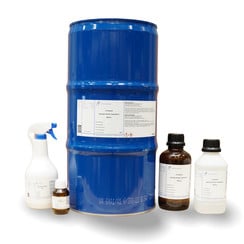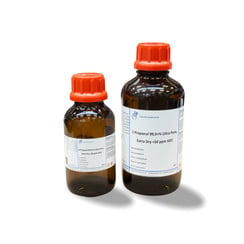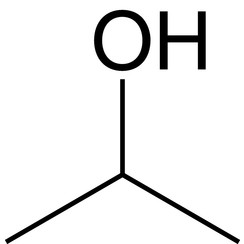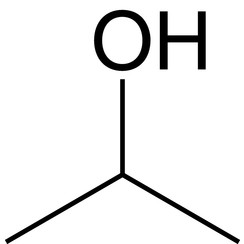You have no items in your shopping cart
2-Propanol
Isopropyl alcohol (IUPAC name propan-2-ol; commonly called isopropanol or 2-propanol) is a colorless, flammable chemical compound (chemical formula CH3CHOHCH3) with a strong odor. As an isopropyl group linked to a hydroxyl group, it is the simplest example of a secondary alcohol, where the alcohol carbon atom is attached to two other carbon atoms. It is a structural isomer of 1-propanol and ethyl methyl ether.
It is used in the manufacture of a wide variety of industrial and household chemicals and is a common ingredient in chemicals such as antiseptics, disinfectants, and detergents.
Isopropyl alcohol is miscible in water, ethanol, ether, and chloroform. It dissolves ethyl cellulose, polyvinyl butyral, many oils, alkaloids, gums and natural resins.Unlike ethanol or methanol, isopropyl alcohol is not miscible with salt solutions and can be separated from aqueous solutions by adding a salt such as sodium chloride. The process is colloquially called salting out, and causes concentrated isopropyl alcohol to separate into a distinct layer.
Isopropyl alcohol forms an azeotrope with water, which gives a boiling point of 80.37 °C (176.67 °F) and a composition of 87.7 wt% (91 vol%) isopropyl alcohol. Water-isopropyl alcohol mixtures have depressed melting points. It has a slightly bitter taste, and is not safe to drink.
Isopropyl alcohol becomes increasingly viscous with decreasing temperature and freezes at −89 °C (−128 °F).
Isopropyl alcohol has a maximum absorbance at 205 nm in an ultraviolet-visible spectrum.
Uses
In 1990, 45,000 metric tonnes of isopropyl alcohol were used in the United States, mostly as a solvent for coatings or for industrial processes. In that year, 5400 metric tons were used for household purposes and in personal care products. Isopropyl alcohol is popular in particular for pharmaceutical applications, due to its low toxicity. Some isopropyl alcohol is used as a chemical intermediate. Isopropyl alcohol may be converted to acetone, but the cumene process is more significant. It is also used as a gasoline additive.
Solvent
Isopropyl alcohol dissolves a wide range of non-polar compounds. It also evaporates quickly, leaves nearly zero oil traces, compared to ethanol, and is relatively non-toxic, compared to alternative solvents. Thus, it is used widely as a solvent and as a cleaning fluid, especially for dissolving oils. Together with ethanol, n-butanol, and methanol, it belongs to the group of alcohol solvents, about 6.4 million tonnes of which were used worldwide in 2011.
Isopropyl alcohol is commonly used for cleaning eyeglasses, electrical contacts, audio or video tape heads, DVD and other optical disc lenses, removing thermal paste from heatsinks on CPUs and other IC packages, etc
Intermediate
Isopropyl alcohol is esterified to give isopropyl acetate, another solvent. It reacts with carbon disulfide and sodium hydroxide to give sodium isopropylxanthate, a herbicide and an ore flotation reagent. Isopropyl alcohol reacts with titanium tetrachloride and aluminium metal to give titanium and aluminium isopropoxides, respectively, the former a catalyst, and the latter a chemical reagent. This compound may serve as a chemical reagent in itself, by acting as a dihydrogen donor in transfer hydrogenation.
Medical
Rubbing alcohol, hand sanitizer, and disinfecting pads typically contain a 60–70% solution of isopropyl alcohol or ethanol in water. Water is required to open up membrane pores of bacteria, which acts as a gateway for isopropyl alcohol. A 75% v/v solution in water may be used as a hand sanitizer. Isopropyl alcohol is used as a water-drying aid for the prevention of otitis externa, better known as swimmer's ear.
Early uses as an anesthetic
Although isopropyl alcohol can be used for anesthesia, its many negative attributes or drawbacks prohibit this use. Isopropyl alcohol can also be used similarly to ether as a solvent or as an anesthetic by inhaling the fumes or orally. Early uses included using the solvent as general anesthetic for small mammals and rodents by scientists and some veterinarians. However, it was soon discontinued, as many complications arose, including respiratory irritation, internal bleeding, and visual and hearing problems. In rare cases, respiratory failure leading to death in animals was observed.
Automotive
Isopropyl alcohol is a major ingredient in "gas dryer" fuel additives. In significant quantities, water is a problem in fuel tanks, as it separates from gasoline and can freeze in the supply lines at low temperatures. Alcohol does not remove water from gasoline, but the alcohol solubilizes water in gasoline. Once soluble, water does not pose the same risk as insoluble water, as it no longer accumulates in the supply lines and freezes but is consumed with the fuel itself. Isopropyl alcohol is often sold in aerosol cans as a windshield or door lock deicer. Isopropyl alcohol is also used to remove brake fluid traces from hydraulic braking systems, so that the brake fluid (usually DOT 3, DOT 4, or mineral oil) does not contaminate the brake pads and cause poor braking. Mixtures of isopropyl alcohol and water are also commonly used in homemade windshield washer fluid.
Laboratory
As a biological specimen preservative, isopropyl alcohol provides a comparatively non-toxic alternative to formaldehyde and other synthetic preservatives. Isopropyl alcohol solutions of 70–99% are used to preserve specimens.
Isopropyl alcohol is often used in DNA extraction. A lab worker adds it to a DNA solution to precipitate the DNA, which then forms a pellet after centrifugation. This is possible because DNA is insoluble in isopropyl alcohol.





